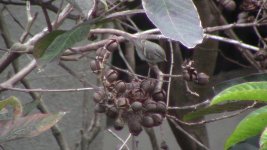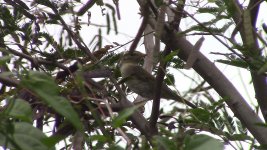-
Welcome to BirdForum, the internet's largest birding community with thousands of members from all over the world. The forums are dedicated to wild birds, birding, binoculars and equipment and all that goes with it.
Please register for an account to take part in the discussions in the forum, post your pictures in the gallery and more.
You are using an out of date browser. It may not display this or other websites correctly.
You should upgrade or use an alternative browser.
You should upgrade or use an alternative browser.
Unknown Warblers Hainan, China (1 Viewer)
- Thread starter Hainan on the fly
- Start date
More options
Who Replied?1 looks better for Hume's Warbler but I don't know the status of it in Hainan.
2&3 is the same individual, no? Somehow looks like a Pale-legged Leaf Warbler to me
No records of Hume's, so a dull Yellow-browed?
Pale-legged looks right.
Last edited:
Deb Burhinus
Used to be well known! 😎

I would have had #1 down as a Hume’s were it not for range but it does have a fairly prominent 2nd wing bar and orangey feet (which doesnt necessarily exclude Hume’s but more frequently favors YBW). Not sure if it’s the image/lighting on the day - a greyish individual here http://orientalbirdimages.org/search.php?Bird_Image_ID=164975&Bird_ID=1837&Bird_Family_ID=&Location=
johnallcock
Well-known member
Hume's is rare in Hong Kong but has increased slightly in recent years. It's feasible on Hainan. Most records of Hume's here are in winter, and this would be unusually early. Yellow-browed, on the other hand, is a very common migrant across southern China.
I don't see anything on this bird to suggest it's not a Yellow-browed. The leg colour favours Yellow-browed over Hume's. The plumage looks slightly greyer toned than normal, but I think that's partly the colour settings on the photograph. Yellow-browed vary slightly in upperpart tone, with some birds greyer than others.
The second bird looks like an Arctic Warbler to me. The legs look too dark/orange-toned for Pale-legged, upperparts/face seem fairly green, supercilium not as pale as Pale-legged. The habitat also favours Arctic - in the canopy rather than grubbing around in dark undergrowth.
(I should add the condition that I can't rule out Japanese/Kamchatka Leaf, but I'd expect them to be brighter and observations so far suggest that Arctic is by far the commonest of the three in south China)
I don't see anything on this bird to suggest it's not a Yellow-browed. The leg colour favours Yellow-browed over Hume's. The plumage looks slightly greyer toned than normal, but I think that's partly the colour settings on the photograph. Yellow-browed vary slightly in upperpart tone, with some birds greyer than others.
The second bird looks like an Arctic Warbler to me. The legs look too dark/orange-toned for Pale-legged, upperparts/face seem fairly green, supercilium not as pale as Pale-legged. The habitat also favours Arctic - in the canopy rather than grubbing around in dark undergrowth.
(I should add the condition that I can't rule out Japanese/Kamchatka Leaf, but I'd expect them to be brighter and observations so far suggest that Arctic is by far the commonest of the three in south China)
Deb Burhinus
Used to be well known! 😎

The second bird looks like an Arctic Warbler to me.
Hi John, that was my first gut feeling but I’ve no experience of separating Japanese/Kamchatka Leaf Warblers from Arctic (I’ve raised this point before elsewhere - from all accounts aren’t they only separable on vocals?) - nor I might add, have I any experience of more than a few of the other leaf warblers in SE Asia (the second link below, which I am sure you are familiar with, is enough to make me hang up my bins for good!) - I’m therefore pretty useless here tbh. The OP has that ‘rangy’ look of an Arctic in addition to the features you point out but the literature doesn’t seem to be clear on the winter range of the 3 and how much overlap there is?
https://www.shanghaibirding.com/wp-...4/Alstrom-et-al-2011-Arctic-Warblers-IBIS.pdf
https://www.shanghaibirding.com/wp-...ing-Birdwatching-Society-nov-2012-English.pdf
Hi John, that was my first gut feeling but I’ve no experience of separating Japanese/Kamchatka Leaf Warblers from Arctic...https://www.shanghaibirding.com/wp-...4/Alstrom-et-al-2011-Arctic-Warblers-IBIS.pdf
Hi Deb: I don't want to pre-empt John, but I think he meant one of the three species which were lumped as Arctic Warbler before the split, not the one of the three which has been given the name after the split.
In my opinion, all three (new) species should have been given new names, so that 'Arctic Warbler' could have been used for the complex without confusion - especially as even Arctic Warbler (new sense) mainly breeds outside the Arctic, so far as I can see.
For what it's worth, I agree with John, with the strong caveat that I don't have experience with possible continental alternatives, but assuming Pale-legged looks like Sakhalin LW with which it used to be lumped, then I don't think Pale-legged is a possibility.
Deb Burhinus
Used to be well known! 😎

Hi Deb: I don't want to pre-empt John, but I think he meant one of the three species which were lumped as Arctic Warbler before the split, not the one of the three which has been given the name after the split.
I was referring to the second and third images of what I agreed with John to be an Arctic. However, regarding the difficulty in ruling out other sp for the second bird in the second and third images, I was referring to Japanese/Kamchatka Leaf warblers as John I believe was in his post. The ‘three’ being
Arctic Warbler P. borealis Kamchatka Leaf Warbler P. examinandus Japanese Leaf Warbler P. xanthodryas .
The Arctic Warbler complex now consists of Arctic Warbler itself P borealis (including the previously named forms kennicotti, talovka, transbaicalicus and hylebata) ranging across northern Eurasia into Alaska; Kamtchatka Leaf Warbler P examinandus in southern Kamtchatka, Sakhalin, Hokkaido and the Kurile Islands and Japanese leaf Warbler P xanthodryas ( in Japan except Hokkaido).
What 3 are you referring to?
Last edited:
I was referring to Japanese/Kamchatka Leaf warblers as John was in his post - what are you referring to?
You're right; I was wrong. Apologies.
But I can't understand any more than you can what John thinks he can see, as opposed to hear, about the differences between these species or sub-species, and especially in autumn. I wonder if it's an assumption about which species will be going through in a particular week than an actual voice ID of the species.
I have lots of Kamchatka come through where I am in central Japan - in the spring in early May to mid-June and coming back in mid to late October (earliest recent records on 16 June 2019, and on return 16 October this year) (all voice as well as views). But I have similar birds coming through at other times, but only got Japanese LW by voice and sight this year, although I think I had seen it on seasonal passage earlier.
Deb Burhinus
Used to be well known! 😎

You're right; I was wrong. Apologies.
No worries
But I can't understand any more than you can ... about the differences between these species or sub-species, and especially in autumn. I wonder if it's an assumption about which species will be going through in a particular week than an actual voice ID ...
I have lots of Kamchatka come through where I am in central Japan - in the spring in early May to mid-June and coming back in mid to late October (earliest recent records on 16 June 2019, and on return 16 October this year) (all voice as well as views) ....
I would think moult timing and movement would be supportive evidence in the absence of vocal identification? Presumably the Kamchatka you get on passage could be worn or fresh depending on wether it’s spring or autumn and depending on their moult strategy? - in Autumn, they would be very worn or very fresh depending on whether they have a complete post breeding moult before migrating or moult on their winter grounds - in Spring, warblers are generally more worn as they tend not to have a pre-nuptial moult but winter moulting birds would be fresher. Residential species would be in fresh plumage in the Autumn. Maybe in the absence of vocals, familiarity with moult strategy and regional movements can help?
I agree, it would be very interesting if John were able to offer some expertise here and maybe throw a little light on any phenotypical/plumage distinctions here!
johnallcock
Well-known member
Haha, don't ask me for insights to ID Arctic/Kamchatka/Japanese from each other  . I only have experience with Arctic. This was the reason that I finished my previous post saying that I can't rule out Japanese & Kamchatka. My understanding is that those two are often brighter/yellower than Arctic, but I have no idea how reliable that is in the field or on photos.
. I only have experience with Arctic. This was the reason that I finished my previous post saying that I can't rule out Japanese & Kamchatka. My understanding is that those two are often brighter/yellower than Arctic, but I have no idea how reliable that is in the field or on photos.
Arctic is the common species in Hong Kong on migration, based on vocalisations and biometrics/DNA of trapped birds. We still have no records of Kamchatka and only a couple of Japanese, whereas Arctic is a common migrant here.
Of course, this does not mean that the other two can't occur in southern China, and I think there are records of Kamchatka (and perhaps also Japanese?) in Guangdong or Guangxi. But based on vocalisations it still seems that Arctic is by far the commonest on the south China coast, and I would guess that also applies to Hainan.
The aim of my post was to point out that I don't think this bird is a Pale-legged Leaf Warbler (or indeed Sakhalin LW, which would be indistinguishable from a photo). What I was saying is that the bird looks like one of the three species in the 'Arctic Warbler complex', and that Arctic Warbler is the most likely of the three species based on current knowledge of the range.
Arctic is the common species in Hong Kong on migration, based on vocalisations and biometrics/DNA of trapped birds. We still have no records of Kamchatka and only a couple of Japanese, whereas Arctic is a common migrant here.
Of course, this does not mean that the other two can't occur in southern China, and I think there are records of Kamchatka (and perhaps also Japanese?) in Guangdong or Guangxi. But based on vocalisations it still seems that Arctic is by far the commonest on the south China coast, and I would guess that also applies to Hainan.
The aim of my post was to point out that I don't think this bird is a Pale-legged Leaf Warbler (or indeed Sakhalin LW, which would be indistinguishable from a photo). What I was saying is that the bird looks like one of the three species in the 'Arctic Warbler complex', and that Arctic Warbler is the most likely of the three species based on current knowledge of the range.
Deb Burhinus
Used to be well known! 😎

Thanks for the clarification John - sorry we put you on the spot but you’re the ‘go to’ person here 
Users who are viewing this thread
Total: 2 (members: 0, guests: 2)








